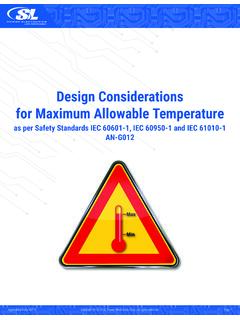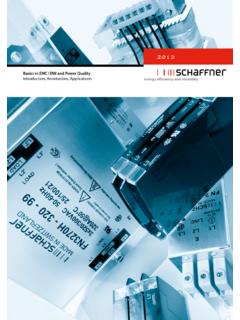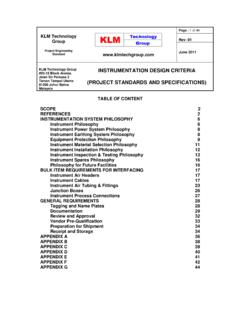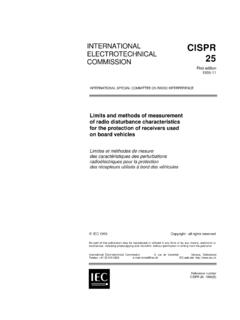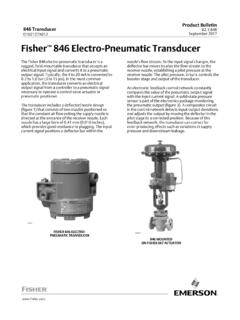Transcription of IEC/EN61000 Standards for Power Supplies
1 SL Power Application Note IEC/EN61000 Standards for Power SuppliesAN-G007 Application Note v0718 Page 1 Copyright 2018 SL Power Electronics Corp. - All rights application note provides a general description of the EMC Standards for Power Supplies , including the test levels and an explanation of the different performance criteria that can be met for each of the least well defined specifications on a Power supply datasheet are the IEC/EN61000 -3 and -4 Standards . Stating that the Power supply complies to a given standard without specifying the test level at which it complies and the performance criteria during the test, does not provide the system designer with enough of the details needed to properly evaluate the effectiveness of the list of pertinent IEC/EN61000 immunity Standards is provided for a quick reference and description of the information provided in this application note is for guidance and may not represent the latest Standards requirement. Consult the actual standard for applicable levels and NumberIEC/EN electromagnetic Compatibility (EMC) immunity Standards Useful for Power SuppliesLimits for Harmonic CurrentLimitation Voltage Fluctuation/FlickerElectrostatic Discharge TestRadiated RFI ImmunityElectrical Fast Transients/BurstMains SurgesConducted RFIM ains Frequency Magnetic FieldPulsed Magnetic FieldDamped Oscillatory Magnetic FieldSupply Voltage Dips and InterruptionsIEC/EN61000-3-2 IEC/EN61000 -3-3 IEC/EN61000 -4-2 IEC/EN61000 -4-3 IEC/EN61000 -4-4 IEC/EN61000 -4-5 IEC/EN61000 -4-6 IEC/EN61000 -4-8 IEC/EN61000 -4-9 IEC/EN61000 -4-10 IEC/EN61000 -4-11 IEC/EN61000AN-G007AN-G007 Application Note v0718 Page 2 Copyright 2018 SL Power Electronics Corp.
2 - All rights Application Note v0718 Page 3 Copyright 2018 SL Power Electronics Corp. - All rights OF TEST RESULTS (Acceptance Criteria)The test results for the various sections of the EN61000-4 Standards are classified in terms of the loss of functionality or degradation of performance of the equipment under test (EUT),relative to a performance level defined by its manufacturer, the requestor of the test, or agreed upon between the manufacturer and the purchaser of the product. The recommended classifications apply to all sections of the standard detailed herein, and are as follows: Criteria A: Normal performance within limits specified by the manufacturer, requestor or purchaser. Criteria B: Temporary loss of functionality or degradation of performance which ceases after the disturbance is removed, and from which the EUT recovers its normal performance without operator intervention. Criteria C: Temporary loss of functionality or degradation of performance, the correction of which requires operator intervention.
3 Criteria D: Loss of functionality or degradation of performance which is not recoverable, owing to damage to hardware or software, or loss of 61000-3-2 Limits for Harmonic Current EmissionsBackgroundIEC/EN 61000-3-2 deals with the limitation of harmonic currents that is supplied from mains network with voltage not less than 220V and current up to and i ncluding 16A per phase. It specifies limits of harmonic components of the input current which may be produced by equipment tested under specified conditions with the exception of the following equipment. Equipment with rated Power less than 75W, except class C equipment Professional equipment with Power >1 kW Symmetrically controlled heating elements with Power 200W Independent dimmers for incandescent luminaries with Power 1 kWPower Supply ConsiderationHarmonic currents are caused by non-linear electric loads such as rectifiers which typically draw non-sinusoidal currents. Some examples of non-linear loads are switch mode Power Supplies , without input current waveform or Power factor correction (PFC), used in office equipment like computers and printers, lighting ballasts, and battery chargers.
4 The nonsinusoidal currents from non-linear loads can become quite complex, but can be broken down into simple sinusoids that occur at multiples of the fundamental frequency of the AC input or harmonics. The greater the value of each current harmonic, the more distortion it puts back onto the AC input can cause higher temperatures in neutral conductors or distribution transformers due to increased currents in the Power system. The higher frequency harmonics can cause additional core losses in motors resulting in additional heat in the motor core. It can also cause changes to the voltage waveform which some electronic components cannot handle. The increased temperatures and inability to handle the voltage distortions can cause the life span of the equipment connected to the AC line to be significantly shortened or cause the equipment to fail the amount of current at each harmonic, decreases the total amount of distortion that is seen on the AC line and thus decreases the effects on other equipment on the AC Application Note v0718 Page 4 Copyright 2018 SL Power Electronics Corp.
5 - All rights A Three phase equipment Household appliances, except class D equipment Stationary, fixed tools Dimming equipment intended to be combined with incandescent lamps Audio equipment Other equipment that is not classified as class B, class C or class D Examples: Frequency converters, cooking appliances, fixed woodworking equipment, lighting dimmers, audio amplifiers, subwoofers, heaters with B Portable tools, non-professional arc welding equipmentClass C Lighting equipment Examples: LED lighting, LED street lighting and other lighting D Equipment type with Power less than 600W (including): Personal computers and similar Television receivers Refrigerators and freezers that are equipped with variable speed drives Examples: Personal computers, tablets, laptops, TVs, emission requirements covered by this standard are up to the 40th harmonic. The table below illustrates the differences between the equipment classifications:Limit linesSee the specific standard for the limits for each of the other h limit values expressed with precision Power factor of the OrderClass AClass AClass CClass Dn[A][A]Expressed as percentage of the input current at the fundamental frequency [%] ,623,450,6423* current per Watt [mA/W]Permissibleharmonic current [A]Current LimitIEC/EN61000AN-G007AN-G007 Application Note v0718 Page 5 Copyright 2018 SL Power Electronics Corp.
6 - All rights 61000-3-3 Limitation of voltage changes, voltage fluctuations and flicker in public low-voltage supply systems (Flicker)BackgroundIEC/EN 61000-3-3 deals with the limitation of voltage fluctuations and flicker that is supplied from mains network with input voltage between 220V and 250V line to neutral at 50 Hz and current up to and including 16A per phase and not subject to conditional connection. It specifies limits of voltage changes which may be produced by equipment tested under specified conditions and gives guidance on methods of Supply ConsiderationsFlicker has to do with the effects of changing loads on the Power utility that would cause lighting to flicker and be a nuisance to people or affect operation of other equipment. Flicker can impair vision and cause fatigue resulting in reduced concentration and workplace accidents. A Power supply with a constant load would not have a problem passing this requirement. However, equipment with a changing load, such as a high powered strobe, may have an issue and the Power supply is limited in filtering this affect.
7 High frequency (>~20-30Hz) would be filtered pretty well, but lower frequency large load changes would flicker indicatorLong-term flicker indicatorRelative voltage changeRelative steady-state voltage changeMaximum relative voltage more than 500msWithout additional conditionsFor equipment which is switched manually or switched automatically more frequently than twice per dayFor equipment which is attended while in use (hair dry-ers, vacuum cleaners, mixers, lawn mowers, electric drills), or switched on automati-cally, or is intended to be switched on manually, no more than twice per dayd(t)dcdmax3,3%3,3%4%6%7%LimitConditio nsIEC/EN61000AN-G007AN-G007 Application Note v0718 Page 6 Copyright 2018 SL Power Electronics Corp. - All rights 61000-4-2 Electrostatic Discharge immunity Test (ESD)BackgroundThe IEC/EN 61000-4-2 standard defines four standard levels of ESD protection, using two different testing methodologies. Contact discharge involves discharging an ESD pulse directly from the ESD test gun that is touching the device unde r test.
8 This is the preferred method of testing. However, the standard provides for an alternate test methodology known as air discharge for cases where contact discharge testing is not possible. In the air discharge test, the ESD test gun is brought close to the device under test until a discharge occurs. The Standards are defined so that each level is considered equivalent a Level 4 contact discharge of 8kV is considered equivalent to a 15kV air Supply ConsiderationsInternal type Power Supplies are meant to be handled only during the manufacturing process, as parts are installed in end equipment. Therefore, the assumption might be that the Power supply is to be designed for and tested to Level 3. However, as internal Power Supplies are increasingly being designed into portable devices such as home healthcare equipment, Power Supplies meeting the Level 4 test parameters will provide the end system designer a more robust Power supply, potentially allowing easier system compliance to Level Power Supplies , however, are commonly handled frequently, and therefore it would be beneficial for engineers choosing an external Power supply for use with their system to opt for a Power supply compliant with Level 4 test LevelsThe ESD threat is divided into four threat levels depending on material and ambient humidity.
9 Threat Level 1 is considered the least severe while threat Level 4 is the most severe. Levels 1 & 2 are reserved for equipment which is installed in a controlled environment and in the presence of anti-static materials. Level 3 is used for equipment which is sparsely but not continuously handled. Level 4 is required for any equipment which is continuously Humidity as low as AntistaticMaterialSyntheticMaterialConta ct Discharge Test VoltageAir Discharge Test Voltage123435%10%50%10%2kV4kV6kV8kV2kV4k V6kV15kVXXXXIEC/EN61000AN-G007AN-G007 Application Note v0718 Page 8 Copyright 2018 SL Power Electronics Corp. - All rights 61000-4-3 radiated , radio-frequency, electromagnetic field immunity test (RF Field Susceptibility)BackgroundThe object of this standard is to establish a common reference for evaluating the immunity of electrical and electronic equipment when subjected to radiated , radio-frequency electromagnetic fields. The test method describes a consistent method to assess the immunity of an equipment or system against a defined phenomenon.
10 This part deals with immunity tests related to the protection against RF electromagnetic fields from any source. Particular considerations are devoted to the protection against radio-frequency emissions from digital radiotelephones and other RF emitting Supply ConsiderationsMost electronic equipment is, in some manner, affected by electromagnetic radiation. This radiation is frequently generated by general purpose sources such as the small hand-held radio transceivers that are used by operating, maintenance and security personnel, fixed station radio and television transmitters, vehicle radio transmitters, and various industrial electromagnetic sources. In addition to electromagnetic energy deliberately generated, there is also radiation caused by devices such as welders, thyristors, fluorescent lights, switches operating inductive loads, the most part, this interference manifests itself as conducted electrical interference and, as such, is dealt with in other parts of the IEC 61000-4 s tandard series.
